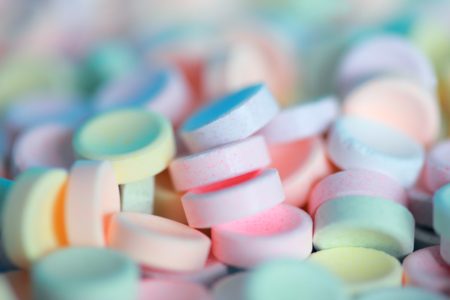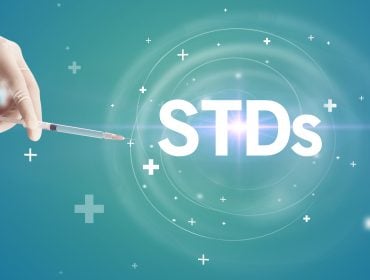PrEP for HIV: A Pill to Prevent AIDS?
Remember high school health class when Coach So-and-so (don’t pretend that your health teacher wasn’t a coach) talked about HIV? Coach Whats-his-face said that HIV was incurable, and once you got it, there was nothing you could do to get rid of it. Coach also said that the only way to prevent HIV was by using condoms or staying abstinent.
While HIV may still be incurable, there have been leaps and bounds in the scientific community to help prevent HIV. Enter: PrEP.
PrEP is a daily pill taken to prevent HIV from developing, should the virus ever enter your body.Maybe you’ve never heard of it. Maybe you have heard of it, but you never took the time to look into it. Or maybe you’ve heard of PrEP, but just don’t know if it’s right for you. Regardless of which category you fall under, with PrEP’s prevention rate of HIV being higher than condoms’ prevention rate, information about PrEP should definitely be in your sexual health repertoire.
So, in order to keep PrEP in your sexual wellness toolbox of information, we need to cover PrEP’s Basics (What PrEP is, How It Works, How Effective It is), Who PrEP is for (People in Monogamous Relationships, People with Risky Behaviors, and People in Certain Demographics), and other PrEP Considerations (Side Effects, Who Should not Take PrEP, and PrEP in Regards to Other Implications). By the end of this post, you’ll be completely prepped for PrEP!
PrEP Basics
Before we get into some of the more nitty-gritty details of PrEP, we need to understand the basics of it. This includes what PrEP is, how it works, and its effectiveness.
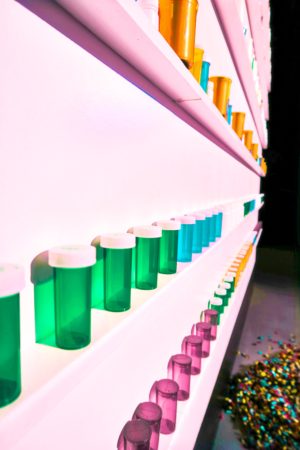
What is PrEP?
Definition
PrEP stands for Pre-Exposure Prophylaxis, but let’s break down what that means:
Prophylaxis is a preventative action taken to prevent disease. This is mainly done by specific means (taking specific drugs), or done against a specific disease (HIV in this case).
Pre-Exposure is before being exposed to the disease
Pre-Exposure Prophylaxis for HIV is when someone who hasn’t been exposed to HIV takes drugs to prevent the disease.
PrEP is taken as a defense to prepare the body in case it ever encounters the disease. The only form of PrEP for HIV currently available is a combination of two HIV medications: tenofovir and emtricitabine. It’s sold under the name “Truvada.”
PrEP History
Scientists have been working on a medication to prevent HIV since the 1980s. Then, in 2012, there was a breakthrough: Truvada was approved by the FDA for over-the-counter sale! Right now it is the only medication that is FDA-approved for pre-exposure prophylaxis. That’s why the term “PrEP” is currently synonymous with “Truvada.”
Potential alternatives to Truvada are currently in trials, but so far none have proven effective in preventing HIV, nor are they FDA-approved. Before 2012, there weren’t any drugs to prevent HIV contraction, but there were drugs to help after exposure to the virus.
PrEP vs PEP
PEP or “Post-Exposure Prophylaxis” is an emergency HIV treatment for people who were recently exposed to HIV. PEP was around before PrEP and is still on the market. It is most used by healthcare workers after they believe they’ve been exposed to the HIV virus. PEP has a much higher drug concentration than PrEP because it needs to block HIV after it’s begun to take hold in the body. It must be taken within 72 hours of exposure to HIV, and the treatment must be continued for a month.
Think of it like birth control pills: Birth control pills are taken daily and emit a small dose of hormones to help prevent pregnancy. If a woman isn’t on birth control pills, and she’s exposed herself to getting pregnant, she’ll need to take a morning-after pill. The morning-after pill is a much higher concentration of birth control hormones because it needs to work immediately to block the pregnancy from happening. PrEP is like birth control pills, and PEP is like the morning after pill. In both cases, pre-exposure prevention is easier on the system than post-exposure prevention.
How Does it Work?
PrEP is an NRTI
As stated before, PrEP is a combination of two drugs: tenofovir and emtricitabine. These two drugs work in very specific ways, but before we can explain how they work, we need to look at how HIV works.
HIV binds to the cell and releases its RNA and enzymes into the cell. HIV then uses Reverse Transcriptase to change its RNA into DNA. Once HIV has DNA, it inserts itself into the cell’s DNA. HIV uses the DNA to make long chains of HIV proteins. It then assembles into new HIV. The new HIV then buds out of the cell.
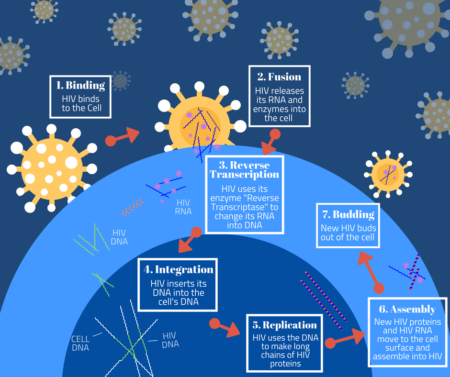
“Antiretrovirals” is a generic term for drugs used to block a retrovirus (like HIV) from replicating. One class of antiretrovirals is Nucleoside Reverse Transcriptase Inhibitors (NRTIs). These antiretrovirals inhibit Reverse Transcriptase from converting HIV RNA into DNA.
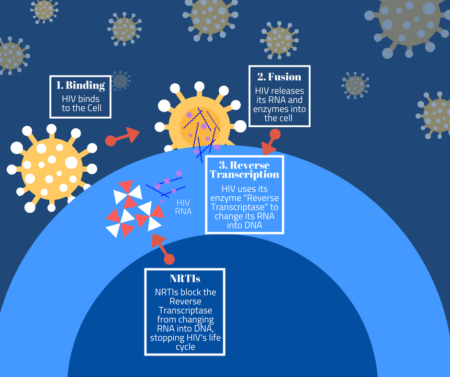
Since the NRTI blocks the HIV RNA from turning into DNA, HIV can’t enter the cell’s nucleus nor can it combine with the cell’s DNA. It blocks HIV from having the ability to take over a cell and replicate within it.
Is PrEP a Vaccine?
Scientists are continuing to work on a vaccine for HIV, but PrEP is an antiretroviral, not a vaccine. Though both of them prevent disease, antiretrovirals and vaccines are two different things.
Antiretrovirals help stop viruses from replicating in the system if they become introduced into the body.
Vaccines introduce a weakened version of a virus into the body. This is done to create a reaction in the immune system called antibodies. Antibodies are produced to fight off the weakened virus. After the antibodies have fought off the weakened version of the virus, the body will be able to quickly make them again should it ever be exposed to a full-strength version of the virus.
How do You Take it?
PrEP is an oral pill that should be taken daily in order for it to be effective. There is no set amount of time to continue taking PrEP; a person must decide for him or herself how long they should take the medicine. A good rule of thumb is to take PrEP for as long as you believe to be putting yourself at risk of contracting HIV. PrEP is only FDA-approved when it is taken daily, and studies that show the effectiveness of PrEP were based on daily dosing. PrEP can be taken with or without food, and it’s recommended to be taken at the same time every day.
What is Its Effectiveness?
How Long Before It Is Effective?
Scientists aren’t sure about how long PrEP must be taken before it becomes fully effective. Some studies suggest that if you take PrEP every day, it reaches its maximum effectiveness in the blood at 20 days, in the rectal tissue at about 7 days, and in the vaginal tissues at about 20 days.
How Effective Is It?
If taken every day for at least 20 days, PrEP is 92% – 99% effective in reducing the risk of contracting HIV. It’s most effective if the drug levels in your body are consistently high. That’s why every day dosing is recommended.
PrEP is 92% – 99% effective in reducing the risk of contracting HIV
Missed Doses
If you miss a dose, don’t worry! Just take the pill as soon as you remember. Once PrEP is built up in the system, it’s very forgiving. A single missed dose won’t tremendously alter PrEP’s effectiveness. But if you find that you’re missing multiple doses in a week, or you begin to notice that you’re missing one dose each week, the effectiveness will decrease and PrEP may not be right for you. It should also be noted that PrEP is much more forgiving for anal sex than vaginal sex. Since it only needs 7 days to build up protection in the rectal tissue, compared to the 20 days needed for vaginal tissue, those who miss doses and engage in anal sex are more likely to remain protected than those who miss doses and engage in vaginal sex.
Who is PrEP for?
The first qualification to be a candidate for PrEP is to prove you’re HIV negative. If you’re unsure about your HIV status and wish to begin taking PrEP, take our HIV test and bring the results to your healthcare provider. Then consider the following questions:
Are You In A Mixed-Status Relationship?
Monogamous Relationship

If you and your partner are in a mutually monogamous relationship, and he or she is HIV-positive, PrEP may be right for you. PrEP will work to keep HIV from replicating within your cells and help you remain HIV-negative. It’s also good to keep in mind that if your HIV-positive partner is managing their HIV well, their HIV viral load may be undetectable. Know that if he or she has had an UVL (Undetectable Viral Load) for over 6 months their HIV is considered untransmissible, and you are at an extremely low risk of contracting HIV. However, if you choose to take PrEP, you’re keeping yourself extra protected, and there’s no such thing as too much protection when it comes to HIV.
Starting a Family
If you are a female, your HIV-positive partner is a male, and you are trying to get pregnant, PrEP is the way to go. It protects you so that neither you nor your unborn fetus will become HIV-positive. PrEP can protect you when trying to conceive, during pregnancy, and while breastfeeding. It’s a great way to allow mixed-status couples to have an HIV-negative baby.
Non-monogamous Relationship
If you and your HIV-positive partner have decided to have an open or a polyamorous relationship, PrEP is a great choice for you and your other partners. It’s always best to disclose your HIV status, your partner’s HIV status, and your PrEP regimen to potential new partners, as well as talk to them about getting on PrEP.
Do You Engage In Risky Behaviors?
Anal or Vaginal Sex Without A Condom
If you engage in anal or vaginal sex with partners whose HIV status is unknown, you’re at substantial risk of contracting HIV. In both vaginal and anal sex, being the receptive partner puts you at the highest risk of obtaining HIV. This also means that being the insertive partner puts you at the highest risk of spreading HIV.
Secure and Confidential
STD testing services
The fastest results possbile - available in 1 to 2 days
Secure and Confidential
STD testing services
The fastest results possbile - available in 1 to 2 days
Sharing Needles/Syringes
If you use needles or syringes for medical purposes, to get high, or for tattoos/piercings, and you’re unsure about the cleanliness of the materials you use, PrEP may be right for you. Sharing dirty needles is a quick way to inject HIV right into your bloodstream; without medicine to stop it, it will begin replicating and taking over your cells.
Sex Workers
If your job involves sexual activity with partners of unknown HIV status, PrEP is for you. It’s necessary to take steps to keep yourself free and clear of all STDs, so consider adding PrEP to your daily regimen to protect yourself and your job security.
Are You A Part of These Demographics?
Studies show that people who are a part of these demographics are at a higher risk of contracting HIV. ***Please note that these factors are based on statistics and do not take into account any specific lifestyle choices***
Sexuality and Race
According to HIV.gov, gay and bisexual men have the highest number of new HIV diagnoses in the United States. This puts them at a higher risk of contracting HIV when having sex with a new male partner. Additionally, blacks and Hispanics are largely affected by HIV more than other racial groups. Finally, transgender women who have sex with men are among the groups at highest risk of HIV infection. If you’re a part of any of these groups, statistically speaking, there is a higher chance of contracting HIV. Of course, whether you get HIV is dependent upon how you live your life and how safe you are.
Location

In 2016 (the most recent data available), California clocked in having the most cases of HIV in the US with 4,961 cases. Florida came in a close second with 4,940, and Texas was third with 4,464. On a county level, Los Angeles County (CA) had the highest number of cases with 1,844, Harris County (TX) had 1,264, and Miami-Diade County (FL) had 1,272.
Location is a risk factor when it comes to HIV contraction. However, it is just a factor. Merely living in a location doesn’t immediately increase your chances of acquiring HIV (just like being gay or being black doesn’t either), but if you live in one of these locations and are dating a lot or dating in a community where HIV rates are high, consider PrEP as a way to protect yourself from the unexpected.
Recent STI
Have you had an STI within the past 6 months? If so, you may be at a higher risk of contracting HIV. Certain STIs, like chlamydia, gonorrhea, and trichomoniasis, can make your body more susceptible to the HIV virus, but, again, this is just a factor. If you don’t engage in risky behaviors, or don’t believe to be putting yourself at risk of contracting HIV, a recent STI is not a reason to get on PrEP. But, if you have had a recent STI and do find yourself in some sticky situations, think about adding PrEP to your daily routine.

Other PrEP Considerations
So now we know What PrEP is, and Who PrEP is for, and you may be wondering if PrEP is right for you or someone you know. But before you make a decision whether to bring up PrEP at your next night out, check out these considerations:
PrEP Side Effects
Minor Side Effects
The following are common side effects of PrEP:
- Nausea
- Vomiting
- Stomach Pain
- Fatigue
- Headaches
- Dizziness
These side effects typically occur within the first month of beginning PrEP and tend to disappear after a few weeks.
Serious Side Effects

Liver Damage – One of the liver’s jobs is to break down harmful substances and remove waste from the body. This is essential to the body functioning correctly, however, the liver sees PrEP as a toxin. The liver then works with the kidneys and other organs to make the medicines in PrEP safer. This can cause the liver to become overworked and succumb to Hepatotoxicity: the official term for liver damage caused by medications or other chemicals.
Kidney Failure – The kidneys filter blood, then reabsorb useful aspects of it. PrEP is excreted by the kidneys, and it can build up in the kidneys causing damage. It can lead to declines in filtration, reabsorption, as well as major tubal damage. The tubal damage (tubulopathy) can disrupt the body’s pH balance as well as lead to bone density loss.
Lactic Acidosis – Lactic acid is a toxic chemical that’s produced when muscles don’t receive enough oxygen. Lactic acid builds up in the blood, but it gets filtered out by the kidneys. If the kidneys aren’t working well because of PrEP, there can be a buildup of lactic acid in the body (Lactic Acidosis). It can lead to major organ failure and death.
Who Should Not Take PrEP
Hepatitis Sufferers
Hepatitis means inflammation of the liver. Due to the problems that PrEP can cause in the liver (outlined above), if you suffer from Hepatitis or have other pre-existing liver issues, PrEP may not be for you.
Kidney Problems
PrEP has shown a mild to moderate decrease in kidney functioning in health users. However, because of the way that PrEP can build up and cause damage to the kidneys, it’s not advised for those with pre-existing kidney problems.
HIV-Positive
This should go without having to be stated again, but if you are HIV-positive, PrEP is not for you. It is a preventative medication (pre-exposure) for people who have not yet been exposed to the virus.
PrEP and Other Factors
Secure and Confidential
STD testing services
The fastest results possbile - available in 1 to 2 days
Secure and Confidential
STD testing services
The fastest results possbile - available in 1 to 2 days
PrEP and HIV Infection
Truvada works wonders preventing HIV, but what would happen if PrEP didn’t protect you and you became infected with the virus? If you acquire HIV while taking PrEP, stop taking PrEP immediately. PrEP is an antiretroviral that works to stop HIV in the early stage of its life cycle. If HIV progresses past its early stage while you’re on PrEP, the virus can build up an immunity to it and other antiretrovirals, making it hard to manage.
PrEP and Screenings
To be on PrEP, you need to get checked by a healthcare provider every 3 months. This is done to ensure that you have no acquired HIV and that the previously stated complications have not arisen. If you’re unable to get checked this often due to work or transportation constraints, consider alternative options.
PrEP and Other STIs
PrEP only prevents HIV infection; it does not prevent against other STIs. When PrEP became FDA-approved, a concern surfaced that it would encourage more people to have unprotected sex, thus leading to more STIs. Since then, there have been studies to both prove and negate that. In 2014, the CDC showed that syphilis was on the rise, and 83% of those cases were from gay and bisexual men. Experts suggest this increase is due to gay and bisexual men using PrEP and not using condoms. However, a 2017 study showed that chlamydia and gonorrhea rates among gay and bisexual men had declined because PrEP users had to be tested more often. With more regular checkups, there’s more of a chance to catch STDs. But when HIV is the main concern, it’s easy to lose sight of the curable STIs.
To Sum it All Up…
Now that you understand What PrEP is, Who it’s For, and Other PrEP Considerations, color yourself PrEP-ared. And even though Coach So-and-so from health class was kind of right: HIV is incurable (currently), and once you get it, you’ve got it; science has progressed since the early 2000s, and we now have a way to prevent you from getting it. Think about if PrEP is right for you or your partner(s). Consult your healthcare provider, and don’t forget to bring them the results of your HIV Test. That way before you walk into the office, you’ll be prepped for PrEP.
Medically Reviewed by J. Frank Martin JR., MD on November 14, 2023
Secure and Confidential
STD testing services
The fastest results possbile - available in 1 to 2 days

Tagged
Categorized As
Author: STD Check Editorial Team
At STDCheck.com, we go to great lengths to ensure quality content. We’re using our own collection of data. It is not bought or made up for “click-bait” purposes. We don’t entice traffic with cheesy graphics or raunchy headlines. Our information is to promote STD testing, educate people, let go of social stigmas, and bring awareness. We also provide a completely confidential atmosphere through private testing. When we produce an article, it is fact-based. We check it with medical advisors that approve it. Our staff consists of doctors and other medical professionals who peer review the content we make available on STDCheck.com. From all over the world, we have sourced the best and the brightest content developers, including medical professionals, marketing engineers, data scientists, content specialists, and media relations.


